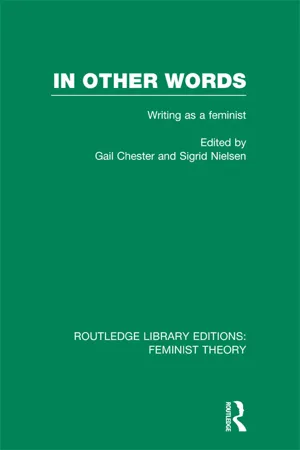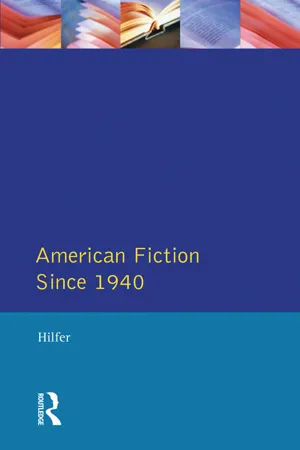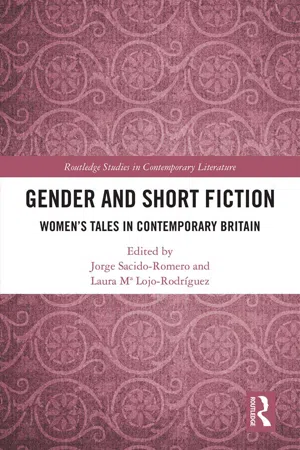Literature
Women's fiction
Women's fiction is a genre that typically focuses on the experiences, relationships, and challenges of women. It often delves into themes such as family dynamics, personal growth, and emotional journeys. While the term "women's fiction" can encompass a wide range of stories and styles, it generally centers on the perspectives and lives of female characters.
Written by Perlego with AI-assistance
Related key terms
4 Key excerpts on "Women's fiction"
- eBook - ePub
In Other Words (RLE Feminist Theory)
Writing as a Feminist
- Gail Chester, Sigrid Nielsen(Authors)
- 2012(Publication Date)
- Routledge(Publisher)
Excellence is not the issue, but who defines it. Now we can turn to feminist writing, both fiction and non-fiction, for a model of literature without aesthetic divisions. For feminism has demonstrated that the division of writing into creative and polemic is artificial and meaningless. Feminists are both, and consider both to be creative writing.Gradually, and as a result of the persistence over many years of many people, there has been a shift in regard for women's writing and feminist fiction – from contempt to acclaim.8 Previously invisible bodies of work from the past and new creations have begun to acquire their (rightful) status – as art. New forms are receiving cultural accreditation: including increasingly the writing of Black women.Feminism also offers evidence of a need for the ‘elevation’ of non-fiction to the level of art and creativity. The Women's Movement has spread and taken root as the largest and most successful world-wide liberation movement this century, arguably surpassing even the great socialist revolutionary movements in insight and achievement. This Movement has taken hold largely as the result of ideas communicated primarily in the form of non-fiction – in the writings of such women as Simone de Beauvoir, Kate Millett, Germaine Greer, Suzie Orbach, Mary Daly, Adrienne Rich, Dale Spender, and the other legions of ‘women of letters’. Women have also discovered that truth is not only stranger, but often stronger, than fiction – and have transformed the forms of life history, biography and autobiography, into revelations and sources of shared power: breaking the silence, revealing the realities of women's lives.9This ‘art’ – of clear thinking communication of the meaning of women's oppression – has taken the creative non-fiction form of:1 ideas that have transformed consciousness, awareness, and understanding, and motivated, i.e. moved, often in a process of catharsis, millions of women to transform their own lives and change the system which oppresses them; - eBook - ePub
Women's Writing in Twenty-First-Century France
Life as Literature
- Gill Rye, Amaleena Damlé(Authors)
- 2013(Publication Date)
- University of Wales Press(Publisher)
11In the work of women writers in the twenty-first century, this self-conscious approach to storytelling is often highlighted in the blurring of boundaries between the fantastic and the banal and can be seen in the writing of, for example, Darrieussecq, NDiaye and Nothomb (see Hutton 2009). Dislocations in narrative voice (Darrieussecq), or the intervention (and death) of the author as a character in the text (Nothomb) alert the reader to the status of the story as a story and to the machinations of storytelling. The death of the author of course provokes the birth of the reader who is often incited to participate actively rather than implicitly in the creative process, being offered the choice between different endings (Nothomb), or being invited to become a character and navigate the story from within (Delaume). In twenty-first-century’s women’s writing, literature and life are collapsed into one another, as Anna Kemp’s contribution to this volume reveals, opening out ways of existing otherwise and inhabiting, through art, the plural, and perhaps contradictory, positions of the self with which so many female authored-texts are concerned. Telling stories, and moreover reading stories, as Holmes suggests in this volume, thus becomes a way for female authors, characters and readers to be creatively and pleasurably suspended in the world.Life-writing is a genre that has long been associated with female-authored works in their discernible emphasis on the intimate spaces of the self, and twenty-first-century women’s writing is no exception. Since the 1980s and into the twenty-first century, Ernaux’s social autobiographies, or autoethnographies, and journaux extimes have continued to blur – but also to reveal anxieties about – the boundaries between the public and the private, and as Simon Kemp analyses in this volume, between the writerly and the experiencing self. The blurred genre par excellence - eBook - ePub
- Tony Hilfer(Author)
- 2014(Publication Date)
- Routledge(Publisher)
Chapter 8 Fiction by Women: Voicing the UnspokenDOI: 10.4324/9781315836560-11(Women) writers
Any consideration of ‘Women's fiction’ should begin with the disputa-bility of the category. Cynthia Ozick's short story ‘Virility’ mocks the idea that there is a recognizable woman's voice, taking it to be a male chauvinist critical construction used to marginalize and trivialize women who write. Joyce Carol Oates in (Woman) Writer proclaims that ‘a woman who writes is a writer by her own definition; but she is a woman writer by others’ definitions’1 . Yet to some feminists it is the denial of a specific woman's voice in fiction that is seen as chauvinist marginaliza-tion, reducing storytellers who are women to mere adjuncts of a male defined and dominated literary canon. In fact, although the highly diverse individual voices of American women writers are reducible to no single measure, their recurrent themes and techniques reflect psychological and political dilemmas specific to contemporary American women. These writers spiritually witness routine social brutality, tell stories about and for those previously left out of the literary and social text, make claims for the powerless, and reveal the courage and resourcefulness of people generally believed to be unimportant and unheroic. Especially, they respond to a male American fixation on untrammelled individualism with the reminder that the freedom of the self is empty without relationship and responsibility. Women writers are concerned with what one needs to be free for rather than of.Another problem in assessing contemporary American fiction by women is the lack of a clear canon. Feminist criticism, now a very powerful force in American academic criticism, has resurrected a number of writers from the past and articulated methods of criticism that enabled readers to see an intelligence and force previously overlooked or even denied in writing by women. Charlotte Perkins Gilman's ‘The Yellow Wallpaper’ (1892) was revived by feminist critics as a classic revelation of how the personal is the political and is now in American literature college anthologies. Feminists rediscovered Kate Chopin's The Awakening (1899) and elevated the stature of such already canonized writers as Edith Wharton and Willa Cather. But although I shall draw heavily from some acute feminist readings of some of the writers in this chapter, feminist criticism has not altogether taken up the challenge of contemporary fiction by American women. Classic writers such as Katherine Anne Porter are generally disliked or ignored by the more prominent and theoretically inclined feminist critics due to her sometimes illiberal politics. Recently, however, theoretical approaches have been applied illuminatingly to Eudora Welty's short story sequence, The Golden Apples (1949), demonstrating precisely the diversity and otherness of voice supposedly absent in predominantly realist writers.2 - eBook - ePub
Gender and Short Fiction
Women's Tales in Contemporary Britain
- Jorge Sacido-Romero, Laura Lojo-Rodríguez(Authors)
- 2018(Publication Date)
- Routledge(Publisher)
Maybe forgetting that in many places of the world women are still a “submerged population” group, Lohafer’s Western-centric and postmodernist view of the subject is currently contested, or at least qualified, by approaches nourished by cultural criticism, post-colonial studies and cross-disciplinarity. These approaches have enabled new voices to be recovered and have offered new insights into the connections between the genre and the sociology of culture. As a result, not only has the short story as a unique and singular genre been pluralised with the emergence of sub-categories such as short story cycles, micro fiction, mini fiction and serial narration; it has also been diversified in terms of the politics of aesthetic: new commonalities linked with cultural territories and identities have appeared, while chapters on “the new woman short stories”, “women’s stories”, “British gay and lesbian short stories” or “Black British short stories” have become parts of edited volumes and companions devoted to the genre.However, there are still studies that follow analytical paths which do not give any particular place to women’s writing as a category: studies centred on the cognitive dimension of “storyness ” and reception, for example, or on “liminality ” as a primarily anthropological notion that contributes to the conceptualisation of the short story.4 Interestingly, whenever the approach to the genre is definitional, philosophical or theoretical, it no longer focuses on how women’s writing might enact a form of cultural and aesthetic revision, and even revolution, of the genre. As Elizabeth Frazer argues in her provocative essay “Is Theory Gendered?” (1996): “the main reason why feminists in particular should waste no time with theory is that it is male or masculine ” (169). In this respect, a work such as Young and Bailey’s British Women Short Story Writers is both timely and essential as it suggests that we do need to engage in discussions on theory as the site where historicist, feminist, formalist and postmodernist approaches can converge or be debated.The continued rise of short fiction anthologies is another focus of interest of this third phase of short story criticism. The frequent grouping of stories according to literary categories, authorship and cultural traditions has led to the proliferation of sub-genres and has conditioned our way of reading stories. New cultural communities have appeared, some grounded in common “experiences”, others linking authors writing in the same sub-genre, within the same period, or authors of the same sex, cultural background or sexual orientation. The contribution of these anthologies to the rising interest in women’s writing has already been acknowledged.5 They testify to the revived interest in how long “obscure” women writers – one example here is Elaine Showalter’s 1993 Daughters of Decadence – have an impact on the revision of the literary canon, and offer a new publishing space for many supposedly “minor” writers. In their prefaces and introductions, some of these anthologies address the question of the intricate set of links between genre and gender. Susan Hill, in The Penguin Book of Modern Women’s Short Stories (1990), and Hermione Lee (1985), in The Secret Self , both tackled the subject cautiously. Hill mentioned the “intimacy” of the form, the recurring themes of childhood and women’s physical isolation and emotional solitude, and suggested that although the short stories in her collection might be enjoyed by both sexes, they “perhaps do speak, at a certain level, very particularly to other women” (Hill 1990: xii). As to Hermione Lee’s rhetorical precautions – “perhaps”, “at a certain level”, “some distinctive angles” – they suggest that the critic did not want to mess assertively with theory and was aware of the dangers of categorising. However, when she wrote: “they are quiet, small-scale, intimate stories – a tone which suits the form best” (Lee 1985: x), we see the underlying risk of such arguments: to construct artificial commonalities and characteristics, to “obscure differences” and invite the reader to read “women’s stories with gendered, stereotypical preconceptions”, as Liggins, Maunder and Robins explain in their introduction to The British Short Story
Index pages curate the most relevant extracts from our library of academic textbooks. They’ve been created using an in-house natural language model (NLM), each adding context and meaning to key research topics.



